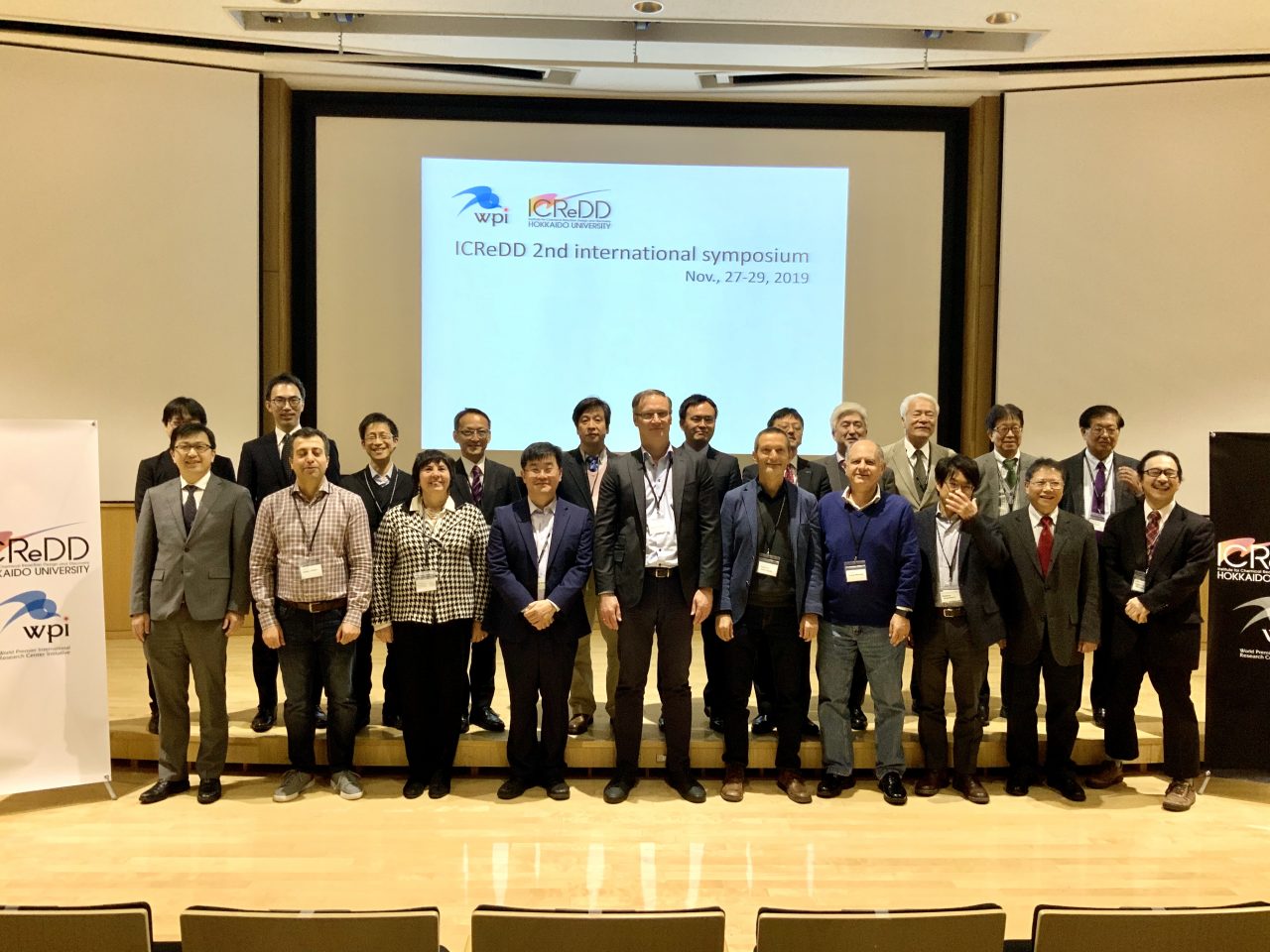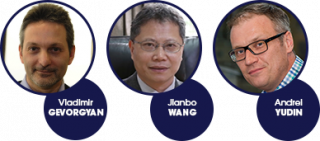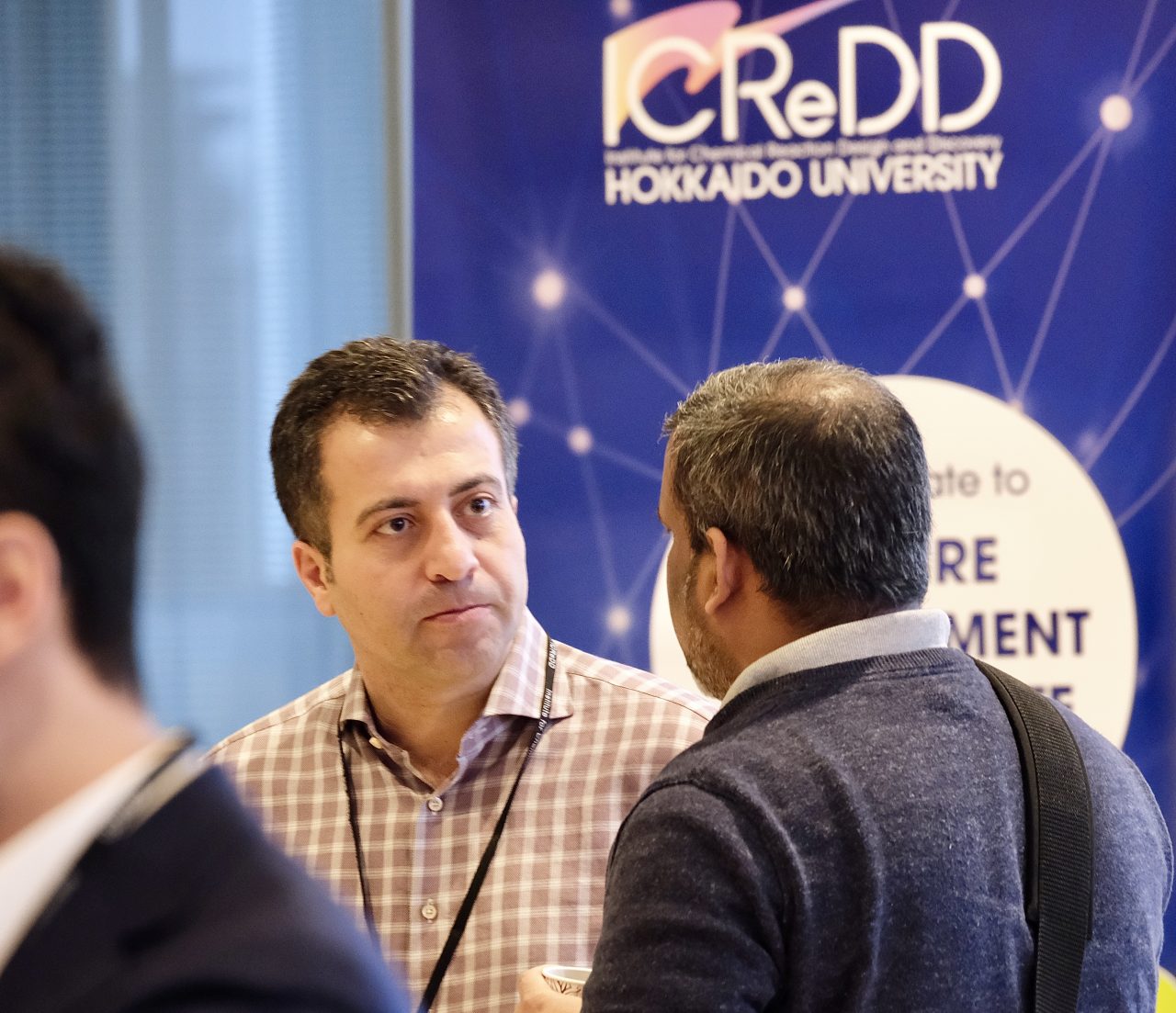Under the motto “Toward Interdisciplinary Research Guided by Theory and Calculation”, the Institute for Chemical Reaction Design and Discovery hosted its 2nd International Symposium in Sapporo from November 27 until November 29.
The speakers came from a wide variety of fields (synthetic chemistry, photochemistry, computational chemistry, information science) united in asking the question: “How can computational chemistry inform experimental practice?”

 Introducing their advanced tools for constructing diverse, many-component chemical structures, three speakers (pictured right)highlighted to the audience the breadth of what is possible in synthetic chemistry today. One of the speakers, Professor Andrei Yudin (University of Toronto), acknowledged: “There is a huge potential for computation and theoretical prediction.” Two speakers from computation science
Introducing their advanced tools for constructing diverse, many-component chemical structures, three speakers (pictured right)highlighted to the audience the breadth of what is possible in synthetic chemistry today. One of the speakers, Professor Andrei Yudin (University of Toronto), acknowledged: “There is a huge potential for computation and theoretical prediction.” Two speakers from computation science  (pictured left) gave complementary presentations by demonstrating the power of modern computational tools to dig deeply into the mechanisms of specific chemical reactions to improve their efficiency. Combining the best of both worlds, the effectiveness of including computational tools as a standard part of the experimental workflow was exemplified by five talks (speakers pictured right)
(pictured left) gave complementary presentations by demonstrating the power of modern computational tools to dig deeply into the mechanisms of specific chemical reactions to improve their efficiency. Combining the best of both worlds, the effectiveness of including computational tools as a standard part of the experimental workflow was exemplified by five talks (speakers pictured right) on designing highly selective catalysts and advanced luminescent materials, with Professor Djamaladdin Musaev (Emory University) phrasing it like this: “You have to use computation and experiments together. We have to be not experimentalists or ‘computationalists’, but scientists!” And Professor Mu-Hyun Baik (Korean Advanced Institute of Science and Technology; pictured left)
on designing highly selective catalysts and advanced luminescent materials, with Professor Djamaladdin Musaev (Emory University) phrasing it like this: “You have to use computation and experiments together. We have to be not experimentalists or ‘computationalists’, but scientists!” And Professor Mu-Hyun Baik (Korean Advanced Institute of Science and Technology; pictured left) even went so far as to ask the question how computational chemists would design chemical experiments to get fully controllable, theory-guided experimental conditions, stating: “Computational chemistry will lead experimentalists to new concepts in chemical reactions.” Adding another perspective to the discussion of how experiments and computation can complement each other, Specially Appointed Associate Professor Ichigaku Takigawa (RIKEN and ICReDD; pictured left), presented his ideas how sparse experimental data can be used to create fast predictions using machine learning.
even went so far as to ask the question how computational chemists would design chemical experiments to get fully controllable, theory-guided experimental conditions, stating: “Computational chemistry will lead experimentalists to new concepts in chemical reactions.” Adding another perspective to the discussion of how experiments and computation can complement each other, Specially Appointed Associate Professor Ichigaku Takigawa (RIKEN and ICReDD; pictured left), presented his ideas how sparse experimental data can be used to create fast predictions using machine learning.
Other opportunities for exchange and learning were a poster session where young scientists took center stage and an overview introduction by ICReDD Director Professor Satoshi Maeda to the AFIR method, the powerful computation software at the heart of ICReDD that can predict whole networks of unknown chemical reactions.
When in the future will theory finally take the lead in chemistry and lead to predictions of unknown chemical reactions? This question, asked by audience members during one of the Q&A sessions, was answered by various lecturers with: “The future is here.” Experimentalists already include computational techniques to various degrees as standard tools in their every-day work, and computational chemists as well as information scientists have long grown past merely rationalizing chemical reactions to influencing experimental designs and predicting new ones based on calculation and data interpretation. This merging of tools and approaches to a new kind of integrated, theory-led chemistry is manifested in the recent establishment of ICReDD to propel the fusion to a new level and fundamentally change the way we approach chemistry.
We are grateful to all speakers and attendees for making this symposium a lively discussion! Thank you for leaving us with exciting questions to expand our research together with our newfound friends!

For a full list of speakers, please refer to this article.

